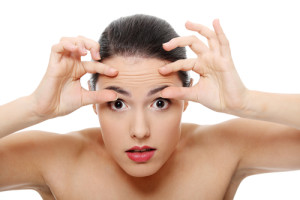Dr. Dean Kane Q & A.

Q. I make a LOT of facial expressions and now I’m noticing a lot of deep lines formed on my forehead even when I’m not scrunching it. Static lines? Do I get Botox or Dysport? Or would I need to get fillers? I’m not big on injectables but I want to smooth out my forehead and the lines between my eyebrows ASAP. I’ve heard of horror stories about droopy eyebrows, people getting bags under their eyes, etc. Do I go to a Facial Plastic Surgeon?

A. Thanks for sharing your photos! It illustrates many of the active or dynamic lines we all create:
- Central vertical creases (“11’s” between the brows) from the corrugator muscles
- The adjacent vertical brow creasing (recruitment lines toward the center) from the orbicularis oculi muscle
- Horizontal line (across the top of the nose) from the procerus muscle
- Oblique mini crease (along the inner corner of the eye) from the depressor supercilii muscle
- The horizontal bilateral forehead wrinkles (raising the brows) from the frontalis muscle
- and, the central forehead “gullwing” creases made from the passive lift of the frontalis or active contraction from the ?procerus muscle extending from the nose up into the mid-forehead.
- There are other lines which your young face does not show radiating from the lateral brow and orbit called “crows feet” from the orbicularis muscle
These lines are created by actively creasing the muscles of expression in the forehead or the muscles of protection around the eyes.
With aging, weather, UV light and thinner skin heritage, the dermis of the skin thins, losing collagen, elastin, hyaluronic acid and other molecules which retain the elasticity, resilience and hydration of the skin. This allows the repetitive creasing by the muscles to etch a line into the skin.
Allowing a muscle relaxer like Botox or Dysport properly injected into appropriate muscles to achieve their optimal effects will provide you the residual skin waviness which may benefit from fillers.
Passive “lines” are similar in their lack of resistant dermal molecules. These are not “wrinkles” because you are not actively bending the skin and muscle relaxers will not help. The big difference is they are made by the continuous laxity and folding of skin as it folds downward against an immobile edge like:
- 1 the cheek making the tear trough or nasojugal fold
- 2 the nose and upper lip making the nasolabial fold
- 3 the corner of the mouth and chin making a marionette fold.
There are many fillers and each has its own characteristics. They vary from a very liquidy smoother, to a thicker volumizer, to a firm and projecting gel. It is up to your well skilled injector to select which filler and at what depth is best for the lines, wrinkles and folds you wish to smooth.
Yes, it’s complicated so it is best to consult with a very experienced, Board Certified Plastic Surgeon, ENT Facial Surgeon or Dermatologist to examine you and review what is best for you. All the best!



